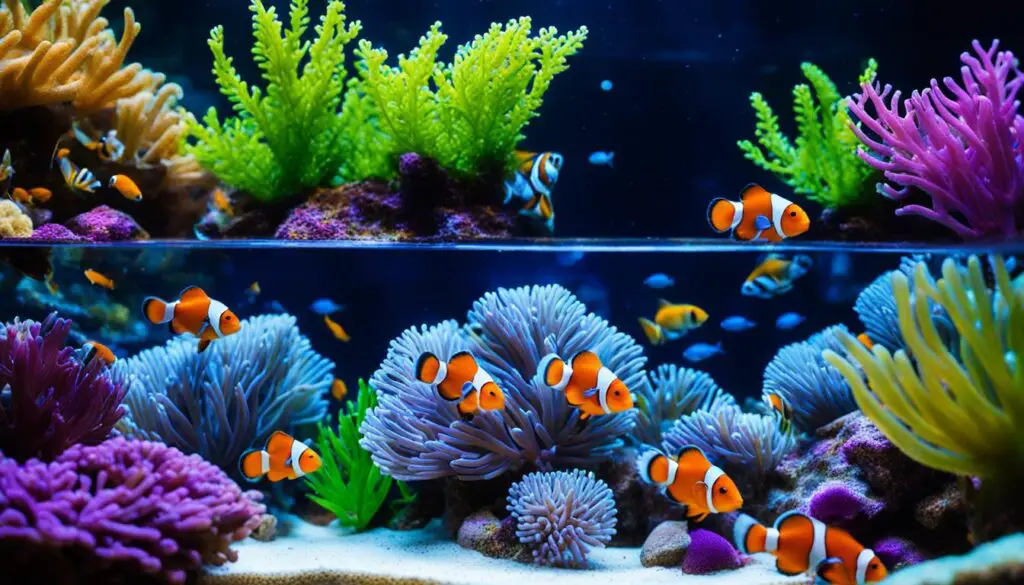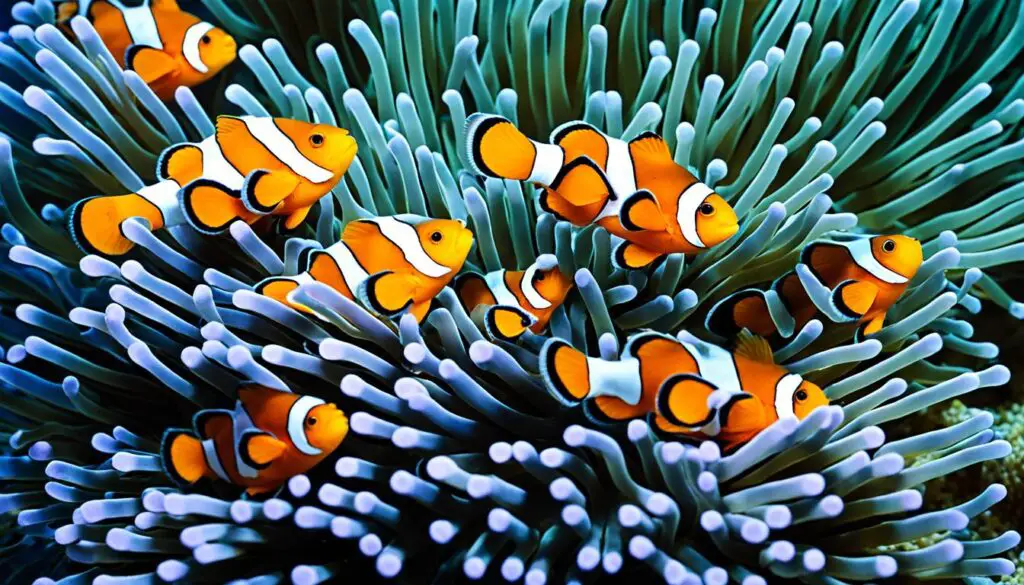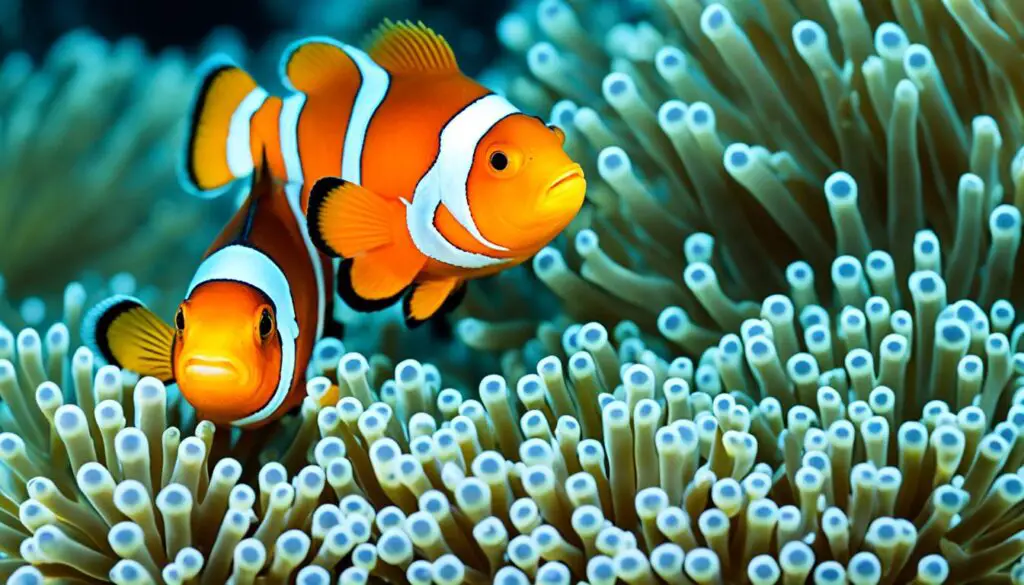7 Tank Setup Hacks for Thriving Clownfish
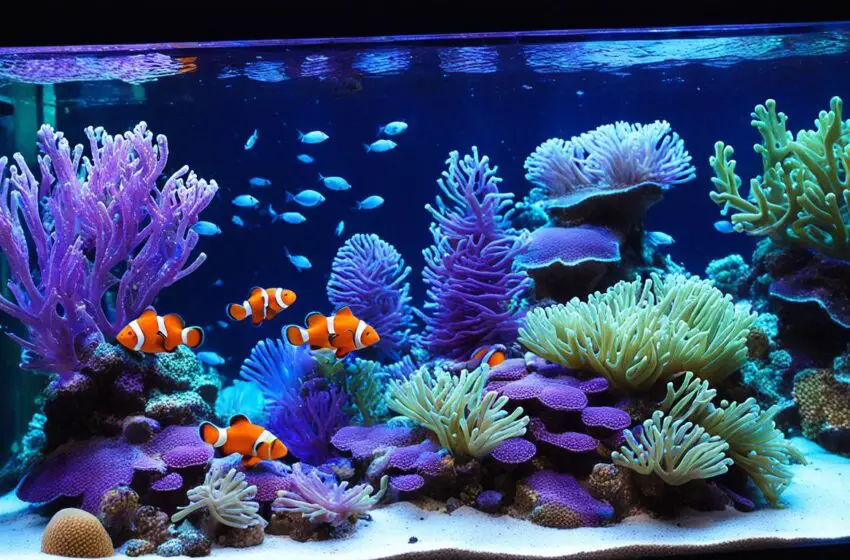
Welcome! This is a guide on making the perfect tank for your clownfish. It doesn’t matter if you’re very experienced or just starting. Making a great place for your clownfish is key to their health. I’ll give you seven tips to help your fish be happy and healthy.
Start by choosing the right tank size. I suggest a 20-30 gallon tank. It gives your fish plenty of room to move and cuts down on fighting.
Make sure the tank is perfect before adding water. This means checking for leaks or being not level. A good start means a safe home for your clownfish.
Having the best filter system is crucial. An undergravel filter works well to keep the water clean. This makes sure your fish stay healthy.
Next, make the tank look natural with substrate and airstones. Substrate is the base and airstones help with oxygen. They make the tank look nice too.
Clownfish need places to hide. You can add rocks, plants, and reefs to give them spots to feel safe. This also makes the tank look better.
Now, it’s water time. Fill the tank and add marine salt. This makes the water just right for your clownfish. It’s important for their health.
Lastly, pick a good spot for your tank. Keep it away from too much sun or big temperature changes. This helps your fish live in a stable place.
Key Takeaways:
- Buy a 20-30 gallon tank to provide a suitable habitat for your clownfish.
- Test the tank for any defects before filling it with water.
- Set up a good filtration system to maintain water quality.
- Add substrate and airstones for a natural environment.
- Create hiding places using rocks, plants, and artificial reef formations.
Choosing the Right Tank Accessories for Clownfish
Creating a good home for your clownfish is more than the tank itself. It’s about picking the right accessories. This makes sure your fish are healthy and happy.
Clownfish like hiding spots. Adding rocks, plants, and artificial reefs makes their tank look great. It also gives them places to hide and feel safe.
For a real ocean feel, think about sea anemones. Clownfish and sea anemones help each other in the wild. But remember, sea anemones are tricky to keep and need care.
Use marine gravel for the bottom after cleaning it well. This keeps the tank clean for your clownfish to explore and look for food.
Consider adding airstones. They’re cool to look at and add more oxygen to the water. Clownfish love well-aerated water.
Good lighting is vital. It helps your clownfish keep a natural day-night cycle. Make sure you pick lights that copy the sun’s brightness and timing.
Check the salt level often using a hydrometer. Clownfish do best with a certain amount of salt. Correct salinity keeps them healthy.
Keep the tank in a safe, quiet place. This keeps your clownfish calm. And it helps them live in a stress-free environment.
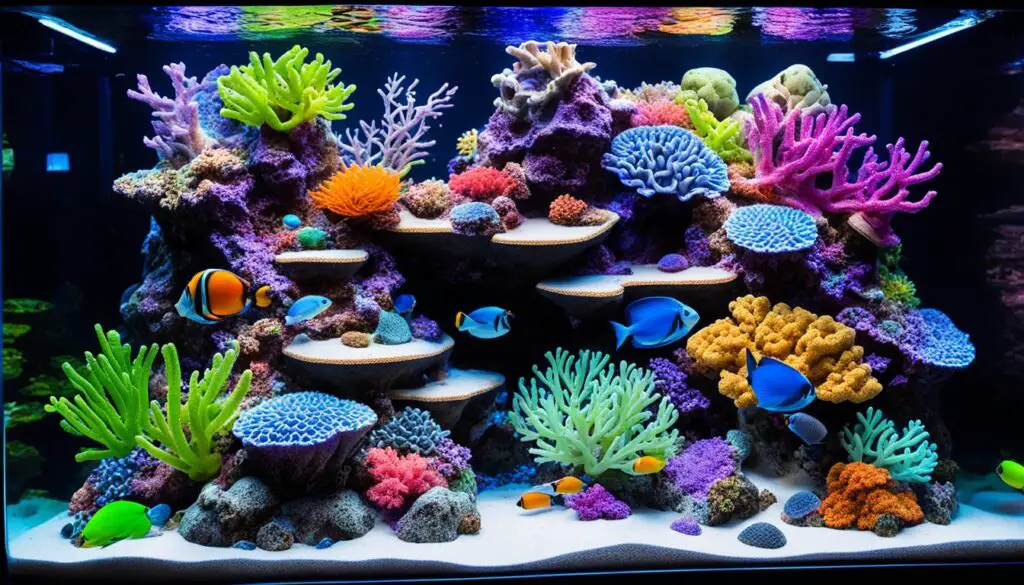
Comparison of Tank Accessories
| Accessory | Benefits |
|---|---|
| Rocks | Provide hiding places and create a natural environment |
| Plants | Enhance aesthetics and offer additional hiding spots |
| Artificial Reef Formations | Create a visually appealing habitat and encourage natural behavior |
| Sea Anemones | Provide shelter and a symbiotic relationship with clownfish |
| Marine Gravel | Creates a suitable substrate for clownfish to explore |
| Airstones | Add visual appeal and improve oxygenation |
| Lighting | Replicate a natural day-night cycle and promote well-being |
Pick the right accessories to give your clownfish a wonderful home. Think about what they need. Like hiding spots, good substrate, and a clean, safe place to live. Do this, and your clownfish will thrive, bringing joy with their antics.
Proper Care and Feeding of Clownfish
Looking after clownfish means getting their diet right and keeping their home perfect. Here’s how to make sure your clownfish stay healthy and happy:
- Give your clownfish quality marine fish flakes once daily. Feed them just enough to eat in two to three minutes. This keeps them well-nourished and full of energy. [feeding clownfish]
- For extra variety, add foods like algae, shrimp, and worms. These mimic their natural diet and ensure they get all their nutrients. It also makes eating more interesting for them. [feeding clownfish]
- Keep the water between 75-85°F, just like their natural homes. A good thermometer helps you watch and adjust the temperature. [maintaining tank temperature]
- Use a light with timers to create a stable day-night rhythm. Clownfish need this for their health and happiness. [clownfish care]
- Always keep the filter clean to prevent water issues. Test the water regularly and maintain the filter to keep their home safe. [clownfish care]
- Check the water’s specific gravity with a hydrometer. The best saltiness for clownfish is 1.020-1.025. Adjust the water with marine salt to keep the right level. [maintaining tank temperature]
- Clean the tank often and change the water. Dirt and waste harm your clownfish. By keeping their home clean, they’ll be at their best. [clownfish care]
Following these tips will keep your clownfish healthy. A good diet, proper tank temperature, and a clean environment are key. They’ll be happy and thriving, bringing life to your aquarium.
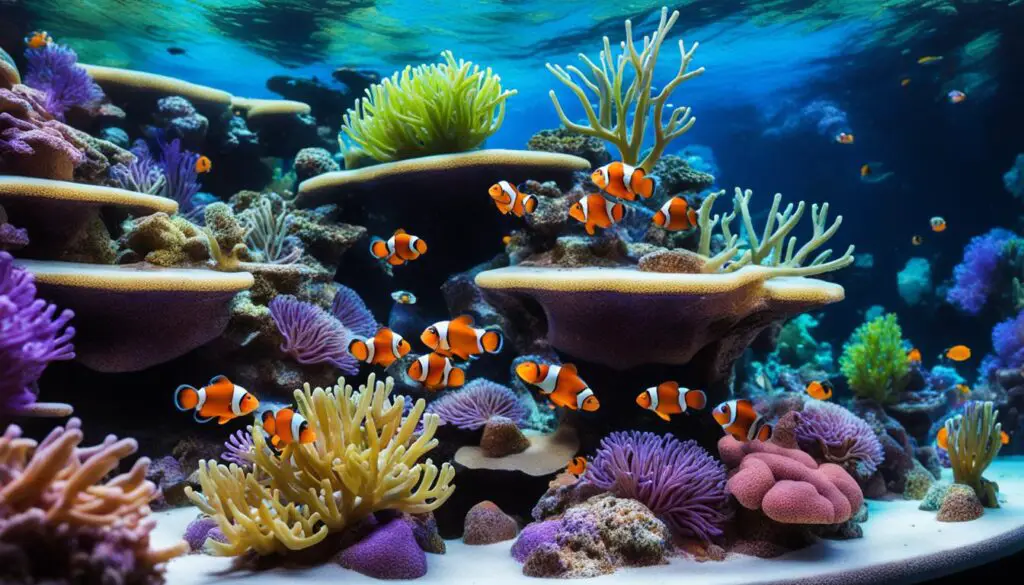
Conclusion
Creating the perfect home for clownfish is key for their health. A big tank with the right filters and hiding spots makes a great home. Also, make sure to feed them well, keep the tank warm, and look after them correctly.
Monitoring the water and doing regular maintenance helps make the tank perfect for them. Check the filters, test the water’s salt level, and clean the tank often. These steps will help you build the best place for your clownfish.
When you set up the tank right, your clownfish will be happy and lively. Understand what they need and give them a home they’ll love. In return, you’ll enjoy happy and colorful clownfish that will make your house more fun.
FAQ
What size tank do I need for clownfish?
Experts suggest getting a 20-30 gallon tank for clownfish. This size is good for their living space. A bigger tank is even better. It keeps the water cleaner and helps reduce fighting over space.
How do I test my tank for defects?
Test your tank before adding water. Look for leaks or whether it sits level.
What kind of filtration system should I use for my clownfish tank?
An undergravel filter is a great choice for a clownfish tank. It helps keep the water clean from dirt and waste.
What accessories should I add to create a natural environment for clownfish?
Add rocks, plants, and fake reef structures for a natural look. They create hiding spots which clownfish love.
How do I maintain the ideal salinity level in my clownfish tank?
To keep the salinity right, start with marine salt in the water. Use a hydrometer to check the water’s salt level.
Where should I place my tank to ensure the well-being of my clownfish?
Keep the tank in a quiet, shaded area. Avoid places where it might get too hot or cold.
What should I feed my clownfish and how often?
Feed them good marine flakes once daily. They should eat all in minutes. Mix in algae, shrimp, or worms for a balanced diet.
How do I maintain the tank temperature for my clownfish?
Aim for 75-85°F to mimic their natural temperature. A good light setup can help control their day and night cycle.
How do I clean and maintain my clownfish tank?
Clean regularly and change the water often to keep it healthy. Always check the water with a hydrometer.
Why is setting up the right tank environment important for clownfish?
The right environment is key for clownfish health. A big tank with the right water and enough hiding spots lets them grow well.
What are some tips for optimizing tank conditions for clownfish?
Feed them, keep the tank warm, and take good care. Also, regularly check the water and do tank maintenance. This helps their health.
How can I create a perfect haven for my clownfish to thrive?
Use our tank setup tips to give your clownfish a place they love. The right environment will help them do well.

